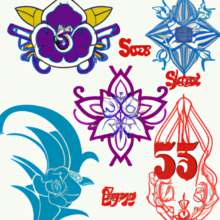Tattoos: Not Just For Bikers Anymore
Tattoos: Not Just For Bikers Anymore
Tattoos, once seen as a symbol of rebellion and individuality, often associated with bikers, sailors, and those living on the fringes of society, have evolved dramatically over the years. Today, the art of tattooing has found its place in mainstream culture, embraced by people from all walks of life. The phrase “Tattoos: Not Just For Bikers Anymore” has never been more fitting. Whether it’s a meaningful design representing personal growth, a commemorative tribute to a loved one, or simply a piece of aesthetically pleasing art, tattoos are now worn proudly by professionals, celebrities, and everyday individuals alike.
The Historical Roots of Tattoos
Tattooing has a rich history that spans across cultures and millennia. Ancient Egyptians used tattoos to mark individuals for religious and medicinal purposes, while in Polynesian cultures, tattoos were a symbol of status and rites of passage. For centuries, indigenous tribes and ancient civilizations utilized tattoos to tell stories of lineage, achievements, and beliefs.
In modern Western culture, tattoos gained prominence in the early 20th century, but they were largely viewed as taboo, associated with criminals, gang members, or those living on society’s fringes. The biker community, in particular, played a significant role in the popularization of tattoos in the mid-20th century. Bikers often chose designs like skulls, flames, and eagles to represent freedom, danger, and the rough and rebellious spirit of their lifestyle. For many years, the common stereotype was that tattoos were synonymous with counterculture, rebellion, and rough-and-tumble lifestyles.
But times have changed, and so has the world of tattooing. The notion that “Tattoos: Not Just For Bikers Anymore” resonates because people from all backgrounds are embracing this form of self-expression, breaking away from the stigmas once attached to body art.
The Rise of Tattoo Culture in Mainstream Society
One of the most significant changes over the past few decades has been the way tattoos have permeated mainstream society. No longer the exclusive domain of outlaws, tattoos have become a popular form of personal expression for everyone from corporate executives to athletes, musicians, and everyday professionals. In fact, in many industries, tattoos are no longer seen as a hindrance to career success. Many workplaces have become more lenient, with policies allowing visible tattoos, especially as the art form becomes more socially accepted.
Celebrities and public figures have played a pivotal role in making tattoos more socially acceptable. Famous actors, musicians, and athletes proudly display their ink, and many have personal stories behind their tattoos. This visibility has helped challenge stereotypes and normalize the idea that tattoos are simply another form of personal expression, like clothing or hairstyle. The sentiment of Tattoos: Not Just For Bikers Anymore is further reinforced when people see their favorite stars, who are role models, getting inked.
Tattoos as Personal Storytelling
Another reason tattoos have moved beyond the biker scene is that they have become a medium for personal storytelling. While bikers may have used tattoos to symbolize their affiliations or beliefs, modern tattoo wearers often get inked to capture their personal narratives, memories, and experiences. Tattoos now range from small, minimalist designs to intricate full-body art pieces that tell deeply personal stories.
For some, a tattoo may represent a significant life event, such as the birth of a child, overcoming adversity, or commemorating a lost loved one. Others use tattoos to express their identity, culture, or spirituality. For example, geometric designs, abstract art, and fine-line tattoos are becoming more popular, moving beyond the bold, traditional designs of the past. Tattoos: Not Just For Bikers Anymore is not just a slogan; it is a reflection of how body art has become a canvas for anyone to communicate their life story.
The Artistic Evolution of Tattoos
As tattoos have become more mainstream, so has the artistry and technical skill behind them. Tattoo artists are no longer simply considered craftsmen but are now respected as true artists, with their work being displayed in galleries and published in prestigious art books. Artists today have access to a wide array of tools and inks, allowing for more precision and creativity in their designs. This artistic renaissance has drawn people from all walks of life, eager to adorn their bodies with unique, one-of-a-kind creations.
Additionally, the rise of social media has helped tattoo artists reach a broader audience, showcasing their portfolios and gaining followers from around the globe. As a result, tattoos are no longer limited to particular subcultures, but rather, they have become an art form that transcends social and cultural barriers.
Conclusion: A Shift in Perception
The evolution of tattoo culture reflects a broader shift in societal perceptions. No longer relegated to the fringes, tattoos have become an inclusive art form embraced by people from diverse backgrounds. The idea of Tattoos: Not Just For Bikers Anymore speaks to this transformation. Body art today is about personal expression, identity, and artistry, with individuals using their skin as a canvas for stories, memories, and creativity. Whether it’s a tiny minimalist design or an elaborate full-sleeve, tattoos have entered the mainstream, leaving behind their old associations and becoming a part of everyday life for millions across the globe.



